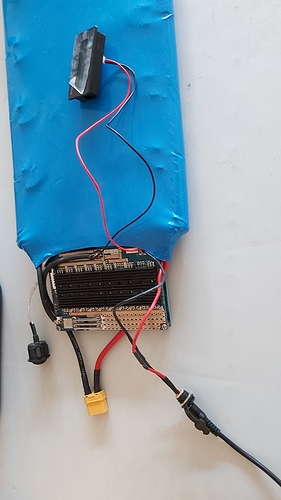Charger is reading 50.65V out so that’s 0.02V over charger…should be fine right?
Yeah you might want to limit it to 4.1V per cell since you don’t get much out of that first .1V anyway it’s basically instantly gone and won’t risk damaging cells from over charging.
Cells can typically take a little over charging but check out Alex Vanover in quad community for how over charging goes wrong  . To be fair he way over charged but it is not great for the cells health/cycles and more volatile when highly charged.
. To be fair he way over charged but it is not great for the cells health/cycles and more volatile when highly charged.
How would I go about limiting that?
It depends on the BMS or balance charger, with balance chargers it’s usually very easy for BMS I’m not sure.
It’s some unknown BMS wrapped up with the pack
The capacitance is the main enemy in this scenario, not voltage. Although more voltage is more bad because it exacerbates the problem.
See this
You’re thermal throttling from the ESC, not the motor. Look at TempPCB vs DutyCycle. As soon as you exceed 80C (The default thermal limit), the duty cycle falls like a rock and you lose power and thus speed.
This is also a little more noticeable than the norm because you’re driving a big powerful motor with a not very big or powerful ESC, thus the ESC overheats before the motor is even hot, just warm.
The only thing I can really recommend is to somehow improve your ESC cooling and/or thermal mass. Neither is particularly easy with a 4.12 ESC though, so you won’t be able to make a ridiculous difference without taking extreme measures.
If you decide you need much higher continuous power handling capability, my only real suggestion is to upgrade to a beefier ESC with provisions for better cooling.
The ESC definitely heats up quick, but what I don’t understand is it looks like the speed and duty cycle hit a minimum before the Temp is above 50. The motor amps are maxed at 60, which is likely what is limiting. If I up the motor max to 80amps as suggested, this may put the esc over the thermal limit. I probably do need to upgrade the esc or go to a dual setup. I don’t have a lot of hills in my area, so I was trying to avoid the dual route.
You are undeniably thermal throttling, and that is undoubtedly what is causing your hill climb to slow down at the end.
Upping your motor amps to 80 will improve your hill climbing, right up to the point that you start throttling, and then do absolutely nothing. In fact, upping your maximum current will almost certainly make your ESC heat up faster, so you throttle sooner.
The vesc is smart, it won’t let you overheat it to the point of failure - that’s the whole point of thermal throttling - to idiot proof things so you can’t melt your board by asking too much of it.
This is an understatement, with 4.12 you’re basically stuck – as the MOSFETs dump the heat mostly into the PCB, not the exposed surface
I was trying to hedge around it, didn’t want to drop a “you’re fucked until you buy more expensive hardware” bomb on a new builder. 
Well to be fair, I have 4.12 VESCs in use right now, I just got off one, in fact. There is nothing wrong with them. They are what they are.
Yeah, I agree. They’re a good basic solution for a low-load (commuter) board. But with his build he’s obviously asking more from them than they can comfortably handle by climbing hills at high speed. As I see it, his options are to either A:) change his riding habits (unlikely), B:) change his gearing so he can’t load the ESC down so hard on hills, C:) go dual 4.12s to spread the load, or D:) upgrade to something beefier like a Flipsky 6.6.
Option A is free, B is cheap, C is quite expensive, and D is similarly expensive, or maybe a little cheaper.
I would go with option c. It would solve these problems the best. Go for option d after completing c.
Of course once option c is completed you’ll now most likely run into the next problem of wanting more range since you’re now bombing hills like nobody’s business and that’s impacting your range now.
Wanting more range also creates the next problem which is needing more space for more powah baybeh and so you’ll probably need a new deck and enclosure to fit it all.
Now your board is getting kind of heavy and you’re now probably considering starting a new build that’s lightweight and for shorter distance aka your grocery board.
By the way have you seen your wallet? Me neither because it ran away like mine did.
Yes, B is what I’d pick, or C.
So I have a brand new build 12S5P battery (samsung 30Q)
With voltage screen, BMS and ON/OFF switch.
I just received my brand new charger and the battery does not charge.
Also on the voltage screen nothing comes up.
The cells were bought brand new from NKON and all part are also brand new.
Any idea why the battery doesn’t charge?
@pjotr47
Switch it on when you charge it.
Still not firing up hey? May need a few more detailed pics of the wiring then. Do the obvious and check your charger is good first though. Get a multi in there
I am talking about the board not the charger when I say switch it on in case that was unclear and you thought I was being a dick. That bms needs to be switched on when charging


